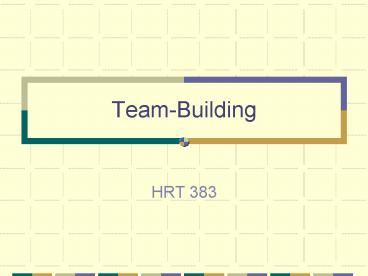Team-Building - PowerPoint PPT Presentation
1 / 24
Title:
Team-Building
Description:
Team-Building HRT 383 Thanks to: Ken Blanchard, Patricia Zigarmi, & Drea Zigarmi, authors of Leadership and the One Minute Manager Ken Blanchard, Donald Carew, and ... – PowerPoint PPT presentation
Number of Views:77
Avg rating:3.0/5.0
Title: Team-Building
1
Team-Building
- HRT 383
2
Thanks to
- Ken Blanchard, Patricia Zigarmi, Drea Zigarmi,
authors of Leadership and the One Minute Manager - Ken Blanchard, Donald Carew, and Eunice
Parisi-Carew, authors of The One Minute Manager
Builds High Performing Teams - R. B. Lacoursiere, author of The Life Cycle of
Groups Group Developmental Stage Theory
3
Thanks to
- Stephen P. Robbins, author of Organizational
Behavior Concepts, Controversies, and
Applications - Tools for Teams Building Effective Teams in the
Workplace, edited by Craig Swenson - Robert H. Woods and Judy Z. King, authors of
Quality Leadership and Management in the
Hospitality Industry - Gary Yukl, author of Leadership in Organizations
4
Individual Development
- Competence
- Knowledge
- Skill
- Commitment
- Confidence
- Motivation
5
Individual Development Stages
6
Coaching Choices
- Directive Behavior
- Autocratic
- Supportive Behavior
- Democratic
7
Coaching Stages
- Directing
- Structure, organize, teach supervise
- Coaching
- Direct and support
- Supporting
- Praise, listen facilitate
- Delegating
- Turn over responsibility for decision-making
8
(No Transcript)
9
Group Development
- Orientation
- Called Forming in Robbins model
- Uncertainty about purpose, structure leadership
- Members are testing the waters
- Dissatisfaction
- Called Storming in Robbins model
- Characterized by intragroup conflict
- Members accept the existence of the team, but
individuals resist the constraints on their
individual style
10
Group Development
- Resolution
- Called Norming in Robbins model
- Characterized by cohesiveness, identity,
structure, and a set of expectations - Members develop closer relationships
- Productivity
- Called Performing in Robbins model
- Structure of the team is fully functioning
- Members energy has moved from getting to know
phases to getting the work done
11
Group Development
- Robbins model includes a final phase called
Adjourning - This would be characterized by a temporary
committee completing a task or achieving results
based upon a goal - Your team may go through these five stages twice
12
Group Developmental Stages
13
(No Transcript)
14
Group Orientation / Forming
- 382 Instructor formed the initial teams
- The Management Plan process was designed to help
you frame your purpose - Instructor(s) offered insight into structure, but
what your team did/does and how it got/gets
accomplished was/is your business - Round I in 382 Round II in 383
15
Group Dissatisfaction / Storming
- What did your team experience in Round I?
- Where was your storm?
- The team itself?
- One individual?
- Your management position?
- Your week of management?
- Formal vs. informal leadership?
- In Round II (383), any storms are usually
weaker!
16
Group Resolution / Norming
- Behavioral Norms
- Team Code of Conduct
- Examples
- Consensus
- Communication
- Commitment
- Conduct
- What did you learn
- in 382?
17
Group Production / Performing
- In 382, getting the management plan done
- Why not just jump right in?
- Creating a guiding purpose
- Team Philosophy
- Team Mission
- Was your team fully
- functioning?
18
Group Adjournment
- Temporary break between quarters
- 383 Round II
- Forming
- Storming
- Norming
- Performing
- Adjourning
19
Types of Teams
- Functional Operating Team
- Cross-Functional Team
- Self-Managing Team
- Self-Defining Team
- Top Executive Team
20
Types of Teams
- Functional Operating Team
- Formal Leader
- Members with similar, but specialized functions
- Example Maintenance crew, SWAT team, sports
- Cross-Functional Team
- Usually has a formal leader
- Members with different functions various
stakeholders - Example Team to begin HACCP or TQM program, or
to kick-off a new promotion
21
Types of Teams
- Self-Managing Team
- No formal leader - leadership may rotate
- Membership similar functions
- External leader, in the same organization, to
direct, coach, support, and delegate - 382 is similar to this model
22
Types of Teams
- Self-Defining Team
- No formal leader - leadership may rotate
- Facilitator acts as leader role rotates
- Membership similar goals or business purpose,
but specialization of roles is possible - Examples Moosewood Restaurant, 383
- Top Executive Team
23
Common Characteristics
Functional Operating Cross Functional Self Managing Self Defining Top Executive
Autonomy-mission Low Low-Mod Low High High
Autonomy- procedure Low-Mod High High High High
Authority-internal High High Low Low High
Duration High Low-Mod High Variable High
Stability High Low-Mod High Variable High
Functional diversity Low High Low Variable High
24
A fully functioning team can
- Work together successfully
- Solve problems and reach decisions in a way that
incorporates individual input - Reach decisions through consensus
- Can adapt to change
- Achieve or exceed desired results































